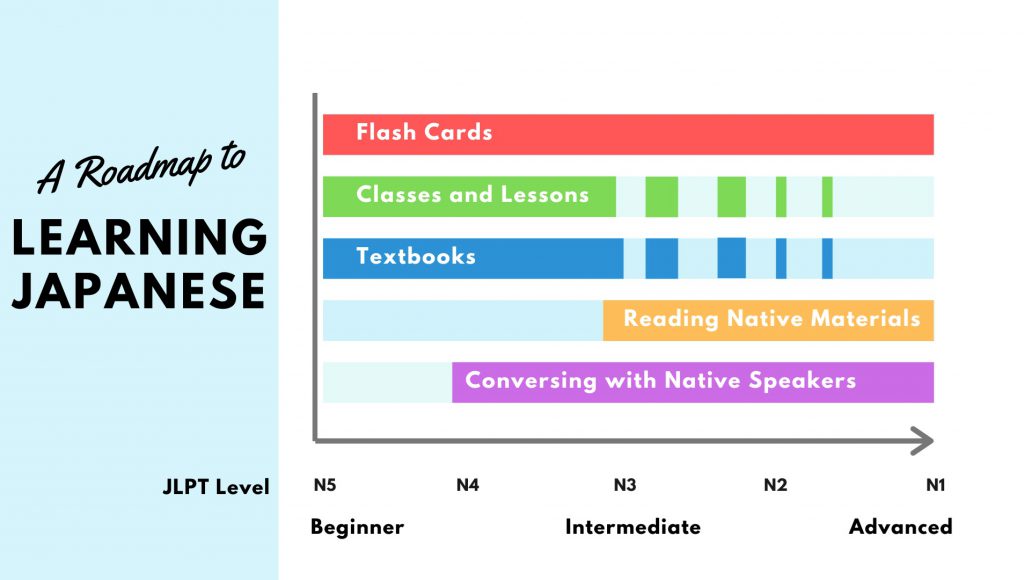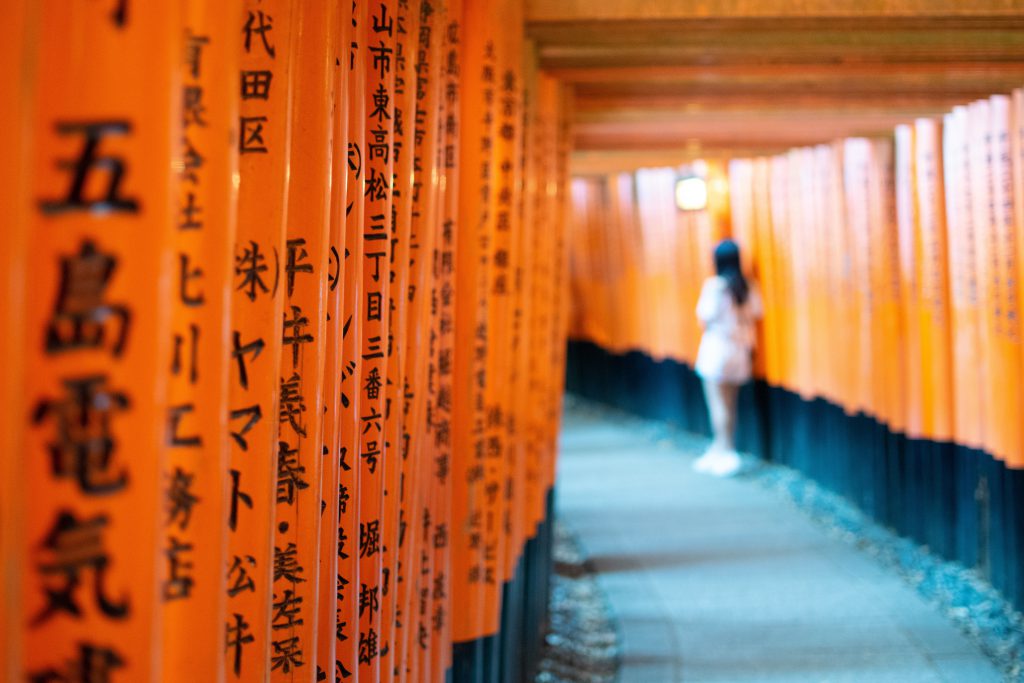A few weeks ago, I was listening to a podcast about learning Japanese, and the host divided learners into two camps: those who use textbooks and those who don’t. I immediately thought, “Wait a second, what’s wrong with something in the middle—occasional textbook use?”
The thought lingered with me long after the podcast was over, and I reflected on my own Japanese learning experience and the ways in which I used several tools and techniques to reach my current level.
That led me to creating this article, a roadmap that reflects my learning journey. There are countless ways to learn Japanese and an equal number of learning styles to combine them with. What follows is simply what has worked for me after a decade of experimentation filled with linguistic hills, valleys, and plateaus in-between. Use this guide to get you started but don’t hesitate to blaze your own trail to fluency.
Getting Started

To chart our course, we’ll be using the diagram above. As I explain it, you’ll get an idea of what language-learning tools and techniques you’ll need as well as when you should consider using them.
The bottom of the chart represents progress according to the “gold standard” of measuring Japanese capability, the Japanese Language Proficiency Test (JLPT). It’s not my favorite methodology, but it’s a commonly accepted reference. So, let’s get started and tackle each of the items on the chart.
Flash Cards
Widely considered to be the most powerful tool in your arsenal, flash cards, preferably digital, are essential from the day you start studying Japanese until the end of your journey (if it ever ends). You’re going to rely on flash cards a lot more in the early stages of learning Japanese. However, even when you reach advanced levels, there are always going to be new words and kanji characters that come into your life, and you need an effective system to capture and memorize them. Get in the habit of creating and reviewing flashcards from the get-go and never look back.
Classes and Lessons
While you’ll find that most language learners swear by flash cards, the effectiveness of a formal education is fiercely debated. This is primarily due to the financial investment required. As a beginner, if you can afford formal classes or private lessons, take them. This is especially true if you need external motivation (i.e. classmates and teachers) to keep a consistent study habit. If money is an issue, consider your local community college where classes are reasonably priced.
Once you reach the intermediate level, you’ll find standard lessons to be less effective—especially if you are living and working in Japan. By this point, you’ll have the foundational knowledge necessary to find the answers to your questions on your own. You’ll be learning by doing, using Japanese every day in your personal and professional life.
This doesn’t mean that you should stop taking lessons entirely. Consider taking focused, intense training as needed: résumé writing, interviewing, or giving presentations, for example.
Textbooks
Ah yes, the topic that started it all. As mentioned, textbooks can be incredibly useful, and you don’t have to commit yourself exclusively to either the “textbook user” or “textbook free” camp. There are plenty of excellent textbooks for beginners, including the Genki series, which are loaded with content to fill up your first flash card decks.
Few textbooks, however, are effective for learning upper-intermediate Japanese (with the exception of test-preparation books) and this coincidently dovetails with the time in your language learning process where you should consider putting textbooks aside for what comes next in your quest for Japanese proficiency.
Reading Native Materials
So now that you’ve cast aside all of your textbooks, what are you supposed to do? Read what everyone else in Japan is reading! Once you reach the intermediate and upper-intermediate levels, the world around you becomes your textbook.
Start reading things that you enjoy: manga, blogs on your favorite hobbies, or famous literary works. It’s not going to be easy. In fact, tackling this kind of content will be downright frustrating at times. But you’ll find it much more enjoyable and rewarding to be reading the same content as everyone else around you. Nothing is more motivating and exciting than the process of graduating from a “language learner” to a “language user.”

Conversing with Native Speakers
You should start speaking Japanese as soon as possible. If you take a good class, you’ll have plenty of conversation partners from day one. Even if you don’t take a class, there are plenty of language exchange apps where a conversation partner is only an app-download away. The key is to develop the confidence to speak out as soon as possible and generate more and more speaking opportunities as you improve.
This may sound like an obvious move. However, it’s tempting to delay output until you feel confident enough to speak. The catch is that you have to speak out before you’ll ever feel confident. Confidence is forged through successful Japanese conversations. Perfect preparation never comes, and if you don’t get used to speaking as soon as possible, mistakes and all, that hesitancy will haunt you throughout your language learning journey.
That being said, as hard as you try, it will be difficult to have extended conversations with native speakers until you at least reach the upper beginner stage—all the more reason that having a teacher or a network of fellow learners is crucial in the beginning.
As you advance, living and working in Japan should provide an escalator of opportunities (travel, job interviews, meetings, etc.) to keep you speaking and learning. Don’t hesitate to mimic everything from pitch-perfect pronunciation to mannerisms and gestures to capture the aura of a native speaker. Your efforts will be noticed and appreciated.
How Long Will Your Journey Take?

You may have noticed that the chart that this article is based on doesn’t have a precise timeline. As mentioned, everyone’s situation is unique. College students may have plenty of time to study while full-time employees with families will be lucky to carve out an hour a day.
The most important thing is to know that fluency is possible, no matter how long it takes. You may just have to run a marathon instead of a sprint. Plan and set your expectations accordingly, and enjoy the journey.





